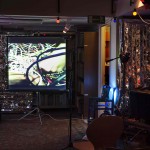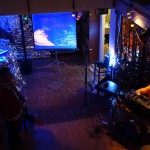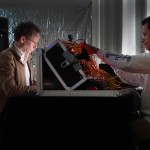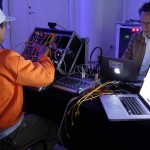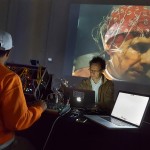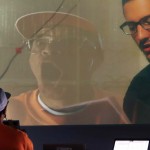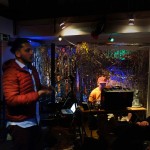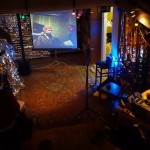1 +1=3: Jean-Louis Huhta (musician and composer), Per Huttner (visual artist) and Hernan Anllo (neuroscientist and hypnotist) at Rönnells Antikvariat in Stockholm, April 2017 and at Växjö konsthall, October 7, 2017.
For the event 1+1=3 proposed a performance with a new hypnotic constellation featuring Jean-Louis, Hernan and Per Huttner performing together. During the event Jean-Louis presented a musical improvisation, which was based on an EEG-recording of Per’s brain activity under hypnotic induction by Hernan. Thay had made a recording in a scientific lab in Paris in November 2016 and Stephen Whitmarsh had worked to bring out an interesting dynamic and merged these recordings to four tracks. Jean-Louis fed these pre-recorded brain signals into his modular synthesizer to shape the control signals into a dynamic soundscape. They used the EEGsynth, a software and hardware that we have developed since 2015.
Before the event began, Hernan hypnotised Jean-Louis. The suggestion made Jean-Louis believe that his modular synthesizer controlled Per’s brain cells and mental capacities. He was asked to “give sense to Per’s brain” and to “put it back together.” It was interesting to note that he found it hard to start the improvisation, since he found the synthesizer (or Per’s brain?) disorganised. It therefore took him some time to get into making music, but he quickly started to develop an interesting soundscape.
Per was also hypnotised to support Jean-Louis. He did so by mixing videos so that the audience could see images of the original hypnotic session in Paris where Per was under deep hypnosis. These images were mixed with real-time videos of Jean-Louis and close-ups of him working with his synthesizer (Per’s brain). The two images were often sandwiched so that their identities were mixed, just like the music was a mixture of our hypnotised brains interacting.
*
From an artistic perspective, the project offers a reflection on artistic authorship and control. All art relates to and reflects on control and degrees of freedom. For the composer it is a question of “controlling” the orchestra, for the musicians to “control” their instruments. But the performance offers other forms of control, since the performers affect each other in ways that remain more or less outside their control. This loss of control opens for new questions: is it Per, Jean-Louis or Hernan who is the author of the sounds and images? Who is it that controls whom during the event? The format of the performance and the interactions between them and the audience forces them to look at the parameters of improvisation, creation and collaboration differently.
*
The event started with a brief introduction about the technology that is used as well as the underlying scientific, artistic and philosophical ideas. Hernan also talked about how medical hypnosis changes attention allocation and modifies the regular functions of cognitive control. After the performance, the audience had the opportunity to ask questions to the three performers and to discuss together. One of the greatest satisfactions of the project was to experience the enthusiasm with which the audience asked their questions and enjoyed the event. It was wonderful to discuss with them afterwards and to see how their reflections deepened the experience of the performance. It brought up new questions, resolved some of the reflections that surfaced during the preparations and event.
A subjective reflection by Per Huttner:
We are interested in questions about human identity. Artistically, we investigate to what degree EEG-signals have a personal uniqueness. Does the signal carry a “fingerprint” of my personality and if so, does that unique trace survive when it transformed into a control signal that Jean-Louis uses to improvise? For the performance, it is important to note that Jean-Louis and I know each other since our early teens, meaning that we have influenced each other over the years through social interaction and by working together. The premise of the show was to investigate what happens when a person who has known me for 35 years uses a recording of my brainwaves to create music. It was interesting in this context to notice that I found Jean-Louis’s improvisation particularly relaxing and soothing. Is that because I somehow could recognise my own brainwaves?
The project was in other words a reflection on how the individuality of our thinking, creation and mental activity interacts when it is translated into different “formats” or “languages.” The scientific recording offers one form of language, the musical compositions another and the moving images a third. Everyone in the room could take in them at the same time, without necessarily knowing how one informed the other. Still, together we were able to reflect on how human minds affect one another when we speak, create together or use other forms of communication than the written or spoken word.

